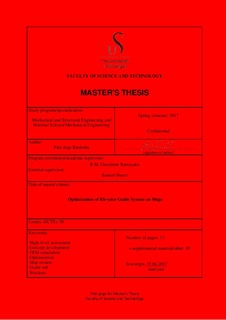| dc.description.abstract | The marine department of thyssenkrupp Elevator in Norway is looking for opportunities to optimize their installations for elevators on ships. Traditionally, their methods are based on the expertise from land-based installations, where the dimensions of the critical components are increased drastically in order to compensate for the potential impacts caused by the maritime conditions. In relation to this, there are reason to suspect over-engineering that effects both the weight and cost of the finished product. In order to get an installation certified, the system must be validated against the requirements for marine operations set by the notifying body. When the ship motions are introduced, the elevator components responsible for maintaining the structural stability is referred to as the Elevator Guide System. This system contains a set of guide rails that shall provide a sufficient support of the moving elements within the shaft and several brackets along the guide that connects the rail to the trunk wall.
An extensive study on existing standards and internal documents related to the issue is conducted in order to identify the essential requirements and how they relate to the application. Based on this research, the mathematical relationships are defined and applied for the appropriate components in order to develop an optimized method for sizing of the guide rails. In addition, a structural analysis is performed for the system, using two alternative constructions for the bracket solution. The alternative methods for executing the installation of the guide system are defined as four separate concepts that are assessed against the principles of complexity, risk and cost.
The analytic results reviled an applicable and highly effective method for sizing of the guide rails, where the optimal dimension within the requirements is suggested for any given project. The conducted FEM-simulation provided a sufficient validation for both bracket solutions against the applied worst-case load conditions that were identified. An estimation of the potential savings across the concepts for installation indicated a significant difference in expenditures related to the applied specifications on sizing method and bracket solution.
The assessment carried out in this study suggests that the concepts based on the traditional method of sizing should not be considered for future installations as the overall reduction potential indicates a substantial advantage of implementing the optimized method, which has been approved by DNV GL as an appropriate method for validation. In addition, the applied bracket solution can severely influence the installation time. However, the preferred bracket is only applicable for elevator trunks with smooth surfaces, which really is the case, as shipyards tend to locate the necessary stiffeners on the inside of the elevator shaft. To resolve this issue, it is recommended that thyssenkrupp establish customer relationships that allows for dialog and discussions regarding the installation related to the elevator specifications in the early stages of a project. In doing so, it should be possible to conduct certain arrangements so that the preferred bracket can be applied. In doing so, the opportunity of implementing the best possible solution for each individual installation should be made feasible. | nb_NO |

